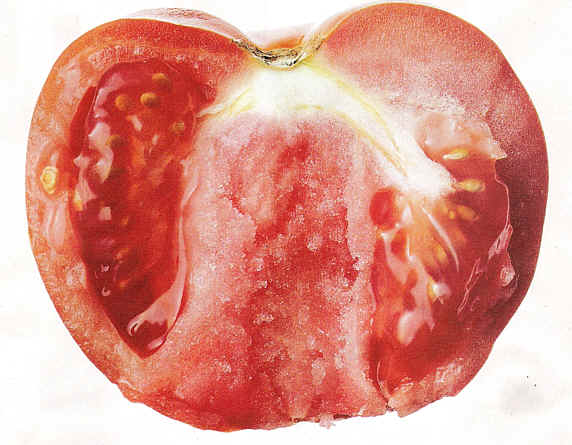|

A product of multimillion-dollar research and development, this
[Hybrid Round Red] tomato was bred on a 17,000-acre Pacific Tomato Growers megafarm in Florida and can be found nationwide, year-round, packaged in cellophane in any mid-level supermarket chain, diced in a Taco Bell taco, or somewhat pointlessly decorating a hamburger. Bred for appearance and consistency, this specimen looks like the Platonic ideal of a tomato (the strict standards of the Florida Tomato Committee govern its appearance), but tastes as though its flavor has been leached out and stored somewhere else.
Red's growth was tightly controlled every step of the way; elements had little opportunity to leave an imprint on it. The seed has been crossbred with other varieties to stave off an array of tomato ailments with names like Fusarium wilt, gray leaf spot, and Alternaria stem canker. The grower adjusts the soil's pH, adds nitrogen, phosphorus, and potassium, and fumigates the plant with pesticide to ward off various insect nemeses.
To simplify packing, the tomato is plucked from the vine before it's ripe, at a stage called "mature green"
-- fully grown but with the texture closer to an apple-and emptied into a vast "gondola" for washing and sorting. From there, the tomato heads by truck to a packing plant, where it receives a disinfecting chlorinated bath, a cooldown (a mature green tomato can chill for two weeks at 58 degrees Fahrenheit without any noticeable consequences), and a stay in the ripening room, a chamber filled with ethylene, which turns tomatoes the desired sunset shade.
Finally, Red is sorted for size, eyeballed for imperfections, slicked with food-grade vegetable wax (making it glossy and impervious to the bumpy ride ahead), and piled into a 25-pound ventilated carton. After a two-day, 1,250-mile journey, it arrives at a New York supermarket, where it can sit for a week without any change in texture or taste, such as it is.
-- Michael Idov, New York Magazine
|